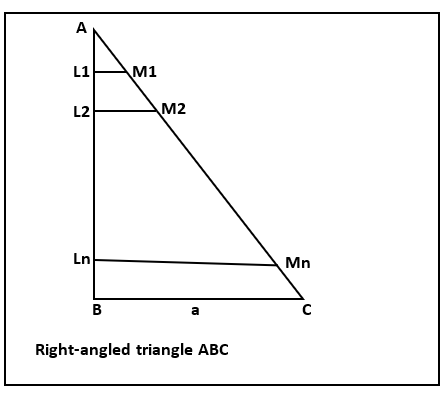
$ABC$ is a right-angled triangle in which $\angle B=90{}^\circ $ and $BC=a$. If $n$ points ${{L}_{1}},{{L}_{2}},....,{{L}_{n}}$ on $AB$ are such that $AB$ is divided in $n+1$ equal parts and ${{L}_{1}}{{M}_{1}},{{L}_{2}}{{M}_{2}},....,{{L}_{n}}{{M}_{n}}$ are line segments parallel to $BC$ and ${{M}_{1}},{{M}_{2}},...{{M}_{n}}$ are on $AC$, then the sum of the lengths of ${{L}_{1}}{{M}_{1}},{{L}_{2}}{{M}_{2}},....,{{L}_{n}}{{M}_{n}}$ is
A. \[\dfrac{a(n+1)}{2}\]
B. \[\dfrac{a(n-1)}{2}\]
C. \[\dfrac{an}{2}\]
D. None of these
Answer
217.8k+ views
Hint: In this question, we have to find the sum of the lengths of the line segments parallel to the base of the given triangle. By using the triangle proportionality theorem, the required series is to be framed, and then by observing the type of the series, the sum is to be calculated using appropriate formula.
Formula Used: If the series is an Arithmetic series, then the sum of the $n$ terms of the arithmetic series is calculated by
${{S}_{n}}=\dfrac{n}{2}\left[ 2a+(n-1)d \right]$ where $d={{a}_{n}}-{{a}_{n-1}}$
If the series is a geometric series, then the sum of $n$ the terms of the series is calculated by
${{S}_{n}}=\dfrac{a({{r}^{n}}-1)}{r-1}$ where $r=\dfrac{{{a}_{n}}}{{{a}_{n-1}}}$
Here ${{S}_{n}}$ - Sum of the $n$ terms of the series; $n$ - Number of terms; $a$ - First term; $d$ - Common difference, and $r$ - Common ratio.
The sum of an infinite G.P is calculated by
${{S}_{\infty }}=\dfrac{a}{1-r}$
Here ${{S}_{\infty }}$ - Sum of the infinite terms of the series
Complete step by step solution: Given that, a right-angled triangle $ABC$ in which $\angle B=90{}^\circ $ and $BC=a$.
There are $n$ points ${{L}_{1}},{{L}_{2}},....,{{L}_{n}}$ on $AB$ such that $AB$ is divided into $n+1$ equal parts .
And ${{L}_{1}}{{M}_{1}},{{L}_{2}}{{M}_{2}},....,{{L}_{n}}{{M}_{n}}$ are line segments parallel to $BC$ and ${{M}_{1}},{{M}_{2}},...{{M}_{n}}$ are the points on $AC$ of the given triangle.
All these are shown in the diagram below:

From the diagram, the lines are parallel to one side of the triangle, then we can apply the proportionality theorem to this triangle. So, that we get
\[\dfrac{A{{L}_{1}}}{AB}=\dfrac{{{L}_{1}}{{M}_{1}}}{BC}\]
On substituting the values,
\[\begin{align}
& \Rightarrow \dfrac{1}{n+1}=\dfrac{{{L}_{1}}{{M}_{1}}}{a} \\
& \therefore {{L}_{1}}{{M}_{1}}=\dfrac{a}{n+1} \\
\end{align}\]
Similarly,
\[\begin{align}
& \dfrac{A{{L}_{2}}}{AB}=\dfrac{{{L}_{2}}{{M}_{2}}}{BC} \\
& \Rightarrow \dfrac{2}{n+1}=\dfrac{{{L}_{2}}{{M}_{2}}}{a} \\
& \therefore {{L}_{2}}{{M}_{2}}=\dfrac{2a}{n+1} \\
\end{align}\]
And
\[\begin{align}
& \dfrac{A{{L}_{n}}}{AB}=\dfrac{{{L}_{n}}{{M}_{n}}}{BC} \\
& \Rightarrow \dfrac{n}{n+1}=\dfrac{{{L}_{n}}{{M}_{n}}}{a} \\
& \therefore {{L}_{n}}{{M}_{n}}=\dfrac{na}{n+1} \\
\end{align}\]
So, the sum of the lengths of these line segments is
\[{{L}_{1}}{{M}_{1}}+{{L}_{2}}{{M}_{2}}+...+{{L}_{n}}{{M}_{n}}=\dfrac{a}{n+1}+\dfrac{2a}{n+1}+\dfrac{3a}{n+1}+...+\dfrac{na}{n+1}\]
On simplifying, we get
\[\begin{align}
& {{L}_{1}}{{M}_{1}}+{{L}_{2}}{{M}_{2}}+...+{{L}_{n}}{{M}_{n}}=\dfrac{a}{n+1}+\dfrac{2a}{n+1}+\dfrac{3a}{n+1}+...+\dfrac{na}{n+1} \\
& =\dfrac{a}{n+1}(1+2+3+...+n) \\
\end{align}\]
Here, the series formed is an arithmetic series and it is predefined as the sum of the $n$ natural numbers.
Since we know that sum of $n$ natural number is \[\dfrac{n(n+1)}{2}\], the required sum is
\[\begin{align}
& {{L}_{1}}{{M}_{1}},{{L}_{2}}{{M}_{2}},....,{{L}_{n}}{{M}_{n}}=\dfrac{a}{n+1}\cdot \dfrac{n(n+1)}{2} \\
& \therefore {{L}_{1}}{{M}_{1}},{{L}_{2}}{{M}_{2}},....,{{L}_{n}}{{M}_{n}}=\dfrac{an}{2} \\
\end{align}\]
Option ‘C’ is correct
Note: Here we need to remember that, if a line is parallel to any one side of a triangle, then we can apply the proportionality theorem for those line segments.
Formula Used: If the series is an Arithmetic series, then the sum of the $n$ terms of the arithmetic series is calculated by
${{S}_{n}}=\dfrac{n}{2}\left[ 2a+(n-1)d \right]$ where $d={{a}_{n}}-{{a}_{n-1}}$
If the series is a geometric series, then the sum of $n$ the terms of the series is calculated by
${{S}_{n}}=\dfrac{a({{r}^{n}}-1)}{r-1}$ where $r=\dfrac{{{a}_{n}}}{{{a}_{n-1}}}$
Here ${{S}_{n}}$ - Sum of the $n$ terms of the series; $n$ - Number of terms; $a$ - First term; $d$ - Common difference, and $r$ - Common ratio.
The sum of an infinite G.P is calculated by
${{S}_{\infty }}=\dfrac{a}{1-r}$
Here ${{S}_{\infty }}$ - Sum of the infinite terms of the series
Complete step by step solution: Given that, a right-angled triangle $ABC$ in which $\angle B=90{}^\circ $ and $BC=a$.
There are $n$ points ${{L}_{1}},{{L}_{2}},....,{{L}_{n}}$ on $AB$ such that $AB$ is divided into $n+1$ equal parts .
And ${{L}_{1}}{{M}_{1}},{{L}_{2}}{{M}_{2}},....,{{L}_{n}}{{M}_{n}}$ are line segments parallel to $BC$ and ${{M}_{1}},{{M}_{2}},...{{M}_{n}}$ are the points on $AC$ of the given triangle.
All these are shown in the diagram below:

From the diagram, the lines are parallel to one side of the triangle, then we can apply the proportionality theorem to this triangle. So, that we get
\[\dfrac{A{{L}_{1}}}{AB}=\dfrac{{{L}_{1}}{{M}_{1}}}{BC}\]
On substituting the values,
\[\begin{align}
& \Rightarrow \dfrac{1}{n+1}=\dfrac{{{L}_{1}}{{M}_{1}}}{a} \\
& \therefore {{L}_{1}}{{M}_{1}}=\dfrac{a}{n+1} \\
\end{align}\]
Similarly,
\[\begin{align}
& \dfrac{A{{L}_{2}}}{AB}=\dfrac{{{L}_{2}}{{M}_{2}}}{BC} \\
& \Rightarrow \dfrac{2}{n+1}=\dfrac{{{L}_{2}}{{M}_{2}}}{a} \\
& \therefore {{L}_{2}}{{M}_{2}}=\dfrac{2a}{n+1} \\
\end{align}\]
And
\[\begin{align}
& \dfrac{A{{L}_{n}}}{AB}=\dfrac{{{L}_{n}}{{M}_{n}}}{BC} \\
& \Rightarrow \dfrac{n}{n+1}=\dfrac{{{L}_{n}}{{M}_{n}}}{a} \\
& \therefore {{L}_{n}}{{M}_{n}}=\dfrac{na}{n+1} \\
\end{align}\]
So, the sum of the lengths of these line segments is
\[{{L}_{1}}{{M}_{1}}+{{L}_{2}}{{M}_{2}}+...+{{L}_{n}}{{M}_{n}}=\dfrac{a}{n+1}+\dfrac{2a}{n+1}+\dfrac{3a}{n+1}+...+\dfrac{na}{n+1}\]
On simplifying, we get
\[\begin{align}
& {{L}_{1}}{{M}_{1}}+{{L}_{2}}{{M}_{2}}+...+{{L}_{n}}{{M}_{n}}=\dfrac{a}{n+1}+\dfrac{2a}{n+1}+\dfrac{3a}{n+1}+...+\dfrac{na}{n+1} \\
& =\dfrac{a}{n+1}(1+2+3+...+n) \\
\end{align}\]
Here, the series formed is an arithmetic series and it is predefined as the sum of the $n$ natural numbers.
Since we know that sum of $n$ natural number is \[\dfrac{n(n+1)}{2}\], the required sum is
\[\begin{align}
& {{L}_{1}}{{M}_{1}},{{L}_{2}}{{M}_{2}},....,{{L}_{n}}{{M}_{n}}=\dfrac{a}{n+1}\cdot \dfrac{n(n+1)}{2} \\
& \therefore {{L}_{1}}{{M}_{1}},{{L}_{2}}{{M}_{2}},....,{{L}_{n}}{{M}_{n}}=\dfrac{an}{2} \\
\end{align}\]
Option ‘C’ is correct
Note: Here we need to remember that, if a line is parallel to any one side of a triangle, then we can apply the proportionality theorem for those line segments.
Recently Updated Pages
Arithmetic, Geometric & Harmonic Progressions Explained

Cartesian Form of Vector Explained: Formula, Examples & Uses

Apparent Frequency Explained: Formula, Uses & Examples

Calorimetry: Definition, Principles & Calculations

Centrifugal Force Explained: Definition, Formula & Examples

Charge in a Magnetic Field: Definition, Formula & Examples

Trending doubts
JEE Main 2026: Application Form Open, Exam Dates, Syllabus, Eligibility & Question Papers

Derivation of Equation of Trajectory Explained for Students

Hybridisation in Chemistry – Concept, Types & Applications

Understanding the Angle of Deviation in a Prism

Understanding Collisions: Types and Examples for Students

How to Convert a Galvanometer into an Ammeter or Voltmeter

Other Pages
JEE Advanced Marks vs Ranks 2025: Understanding Category-wise Qualifying Marks and Previous Year Cut-offs

NCERT Solutions for Class 11 Maths Chapter 10 Conic Sections

NCERT Solutions for Class 11 Maths Chapter 9 Straight Lines

NCERT Solutions For Class 11 Maths Chapter 8 Sequences And Series

NCERT Solutions For Class 11 Maths Chapter 12 Limits And Derivatives

Understanding Atomic Structure for Beginners




